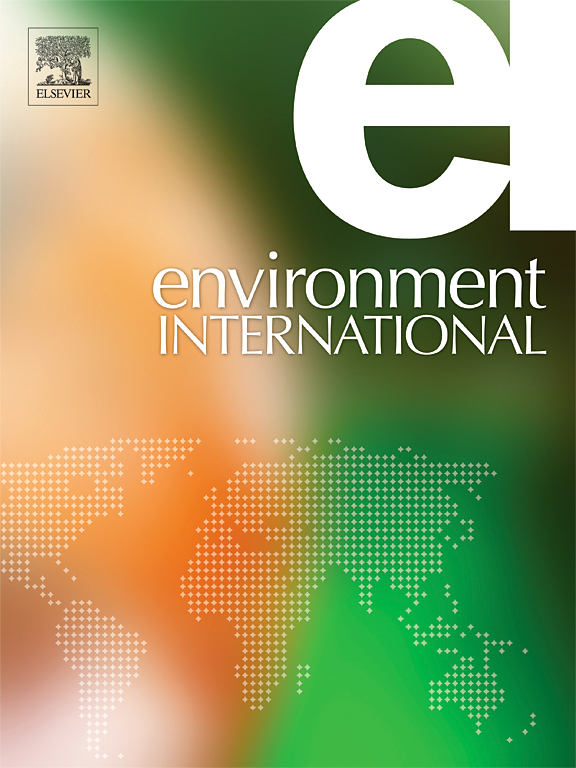利用生物和灰尘测量结果与社会人口和住房变量配对,了解产前家庭接触全氟和多氟烷基物质的情况
IF 9.7
1区 环境科学与生态学
Q1 ENVIRONMENTAL SCIENCES
引用次数: 0
摘要
全氟烷基和多氟烷基物质(PFAS)是令人担忧的化学物质,它们无处不在,具有持久性,对健康有已知和可疑的影响。经深入研究,接触 PFAS 的主要来源是饮用水和食物。一般人群的人体组织中存在 PFAS,这表明还有其他重要的接触源/途径。住宅灰尘测量结果表明,住宅中广泛存在 PFAS。有限的研究报告对室内介质中的 PFAS 含量和血清中的 PFAS 浓度进行了配对分析。虽然目前很少有室内灰尘和血清的配对样本,但全国儿童研究 (NCS) 中包含配对样本以及参与研究的孕妇的社会人口信息。我们利用这些存档的 NCS 数据和在 2009 年至 2014 年间收集的 104 名参与者的标本,对 16 种常测的 PFAS 进行了分析。我们评估了家庭中的 PFAS 水平、灰尘和血清中的 PFAS 与社会人口或住房变量之间的关系。此外,我们还采用了机理暴露模型和具有简单参数的稳态血清水平模型来估算粉尘中 PFAS 对血清的影响。血清中最常见的全氟辛烷磺酸(全称见表 1)的几何平均数为PFOS 为 4.1 纳克/毫升,PFOA 为 1.1 纳克/毫升,PFHxS 为 0.87 纳克/毫升,PFDA 为 0.16 纳克/毫升。灰尘中 PFAS 的几何平均数为PFOS 为 17 微克/千克,PFOA 为 16 微克/千克,PFDS 为 9.6 微克/千克,PFHpA 为 4.5 微克/千克,PFNA 为 4.4 微克/千克,PFHxS 为 3.9 微克/千克,PFDA 为 3.5 微克/千克,PFDoA 为 2.3 微克/千克,PFUdA 为 2.1 微克/千克。在血清和灰尘中检测到的 PFOA 与 50% 的血清和灰尘中检测到的所有 PFAS 的总和明显相关。血清中的 PFAS 与以下因素密切相关较高的收入、最近的装修、在家中居住的年数和教育程度。灰尘中的 PFAS 与以下因素有很大关系参与者年龄较高、住宅类型、地毯数量、教育程度、收入较高、近期装修和军人身份。对于某些 PFAS 来说,平均 25% 的总暴露量来自灰尘,但对于其他 PFAS 来说,3-4% 来自灰尘。这样,我们就能更清楚地了解这些家庭中存在哪些全氟辛烷磺酸、其含量如何、它们之间的关系如何,以及它们如何与社会人口和住房因素联系在一起。我们的研究结果表明,通过住宅灰尘接触到的全氟辛烷磺酸可能占成人总接触量的 25%,这突出了了解住宅接触全氟辛烷磺酸的驱动因素的重要性。本文章由计算机程序翻译,如有差异,请以英文原文为准。
Understanding prenatal household exposures to per- and polyfluorylalkyl substances using paired Biological and dust measurements with sociodemographic and housing variables
Per- and poly-fluoroalkyl substances (PFAS) are chemicals of concern—they are ubiquitous, persistent, with known and suspected health impacts. Well studied, primary sources of exposure to PFAS are drinking water and food. The presence of PFAS in human tissue of general populations suggests other important exposure sources/pathways. House dust measurements suggest widespread presence of PFAS in residences. Limited studies report paired analyses of PFAS occurrence in indoor media and PFAS concentrations in serum. While paired samples of house dust and blood serum are currently rare, the National Children’s Study (NCS) contains paired samples, as well as sociodemographic information, from pregnant people that participated in the study. These archived NCS data and specimens for 104 participants collected between 2009 and 2014 were leveraged and analyzed for 16 commonly measured PFAS. We evaluated PFAS levels in the home, and the relationships between PFAS in dust and serum, and sociodemographic or housing variables. In addition, mechanistic exposure models, and then steady-state serum level models with simple parameters were used to estimate dust contributions of PFAS to serum. The geometric means for the most commonly found PFAS (full names in table 1) in serum were: 4.1 ng/mL for PFOS, 1.1 ng/mL for PFOA, 0.87 ng/mL for PFHxS, 0.16 ng/mL for PFDA. The geometric means of PFAS in dust were: 17 µg/kg for PFOS, 16 µg/kg for PFOA, 9.6 µg/kg for PFDS, 4.5 µg/kg for PFHpA, 4.4 µg/kg for PFNA, 3.9 µg/kg for PFHxS, 3.5 µg/kg for PFDA, 2.3 µg/kg for PFDoA, 2.1 µg/kg for PFUdA. PFOA was significantly correlated in serum and dust as was the sum of all PFAS detected in > 50 % of serum and dust. PFAS in serum was significantly associated with: Higher income, recent renovations, years lived in the home, and educational attainment. PFAS in dust was significantly associated with: Higher participant age, type of home, amount of carpet, educational attainment, higher income, recent renovation, and membership in the military. For some PFAS, 25 % of the overall exposure, on average, is from dust, but for others, 3–4 % is attributed to dust.
We were able to identify important associations in PFAS exposure in the homes of pregnant people based on paired serum and dust samples. This built a clearer picture of which PFAS and at what quantities they exist in these homes, how they relate to each other, and how they are tied to sociodemographic and housing factors. Our results demonstrate that exposure to PFAS via house dust may contribute up to 25% of total exposure for adults, highlighting the importance of understanding what drives residential exposures.
求助全文
通过发布文献求助,成功后即可免费获取论文全文。
去求助
来源期刊

Environment International
环境科学-环境科学
CiteScore
21.90
自引率
3.40%
发文量
734
审稿时长
2.8 months
期刊介绍:
Environmental Health publishes manuscripts focusing on critical aspects of environmental and occupational medicine, including studies in toxicology and epidemiology, to illuminate the human health implications of exposure to environmental hazards. The journal adopts an open-access model and practices open peer review.
It caters to scientists and practitioners across all environmental science domains, directly or indirectly impacting human health and well-being. With a commitment to enhancing the prevention of environmentally-related health risks, Environmental Health serves as a public health journal for the community and scientists engaged in matters of public health significance concerning the environment.
 求助内容:
求助内容: 应助结果提醒方式:
应助结果提醒方式:


